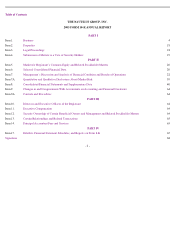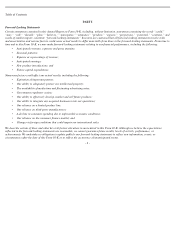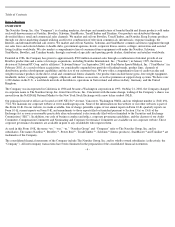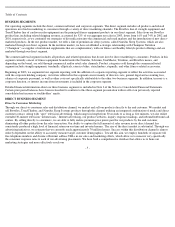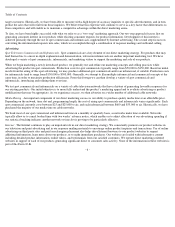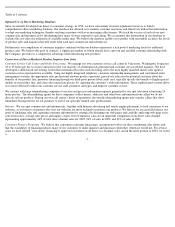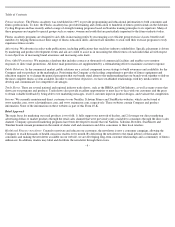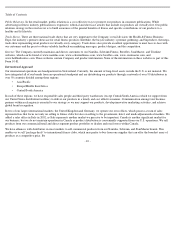Nautilus 2003 Annual Report Download - page 13
Download and view the complete annual report
Please find page 13 of the 2003 Nautilus annual report below. You can navigate through the pages in the report by either clicking on the pages listed below, or by using the keyword search tool below to find specific information within the annual report.
Table of Contents
The U.S. fitness equipment market consists of two distinct market segments: home and institutional. The institutional, or commercial, fitness
market is more visible to consumers, but the home market is much larger and has experienced much of the meaningful growth in the overall
market. Based on statistics provided by the SGMA, 2003 sales of home equipment by manufacturers in wholesale dollars totaled approximately
$3.2 billion, representing more than 80% of the overall fitness equipment market. We believe these wholesale dollars translate to approximately
$6.4 billion in retail sales of home fitness equipment in 2003, representing a compound annual growth rate of approximately 10% since 1990.
In contrast, the SGMA reports that sales of commercial fitness equipment totaled approximately $0.7 billion in 2003, which is flat compared to
2002. We estimate our target market to be approximately $5.0 billion as our products are sold at both wholesale and retail prices.
According to the SGMA, the fitness equipment market increased an estimated 2.8% in 2003 after less than 2.0% growth during the previous
two years. Market conditions improved during the second half of 2003 consistent with the broader U.S. economic recovery. According to the
SGMA, the outlook for 2004 is even better, with projected growth of 3.9% in fitness equipment sales. The SGMA cites anticipated continued
economic recovery, continued expansion of the new housing market where consumers have trended to building larger homes, and a renewal of
health club expansion plans in light of the recent economic recovery as reasons for the growth expectation.
The SGMA identifies strength training equipment as an expanding segment of the fitness equipment market. Cardiovascular fitness equipment
has historically been and continues to be the most popular with consumers. Treadmills have been best sellers among the cardiovascular fitness
equipment category representing approximately one-third of overall fitness equipment sales in 2002. The outlook for strength training
equipment is positive as its use is becoming widely recognized not just for its impact on appearance, but also for the health benefits it can
provide. According to a survey by American Sports Data, Inc., the number of Americans who frequently used strength equipment in their
workout routines increased approximately 65% from 1990 to 2002 compared to 35% growth in the use of cardiovascular equipment.
The international markets represent a strong opportunity for growth, driven by the continued fitness boom across Europe and the increasing
focus on fitness and healthy lifestyles by more affluent consumers in Asia and Latin America. In fact, according to recent data published by the
International Health, Racquet and Sportsclub Association (the “IHRSA”), there are approximately 29,000 health clubs in Europe, 7,800 in
Latin America and 4,800 in the Asia/Australia market. For comparison, there are approximately 22,000 clubs currently operated in the U.S.
According to the IHRSA, health club memberships in the United Kingdom totaled 4.4 million in 2002 compared with 1.5 million in 1996, an
increase of 194%. Health club memberships in Germany totaled 5.4 million in 2002 compared with 3.3 million in 1995, an increase of 64%.
We believe demand for U.S. products will increase, as foreign consumers increasingly demand the reliability, service and innovative designs
provided by U.S. suppliers.
Trends in Rest Products
The United States mattress market is large and dominated by several major manufacturers whose primary focus is the conventional innerspring
mattress. According to the International Sleep Products Association (the “ISPA”), United States mattress and foundation sales totaled 38.9
million units shipped in 2002, representing a 0.7% increase from 2001. Total dollar value of these wholesale shipments increased 3.8% to $4.8
billion in 2002 compared to 2001. We believe these wholesale dollars equate to over $8.0 billion in retail sales. The ISPA attributes this growth
in 2002 to the significant expansion in the housing market, where new housing starts increased by approximately 5% in 2002. We believe the
market for specialty sleep systems to be approximately $1.0 billion.
-
12
-


